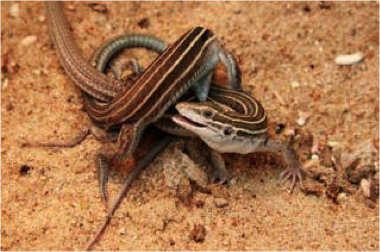7.0 Introduction
Asexual, lesbian lizards
It is difficult to mistake whiptail lizard copulation for anything else (Figure 7.1). A lizard mounting another lizard from behind certainly suggests sex. However, whiptail lizards of the genus Apidoscelis are all females and reproduce asexually. Eggs are produced through meiotic division, but then undergo a doubling of chromosomes to return to a full set of chromosome pairs. This type of asexual reproduction, in which embryos develop from unfertilized eggs, is called parthenogenesis (from the Greek, meaning “virgin birth”), and is seen in many plants and animals.
These lizards are doubly intriguing because they may exhibit a stereotypical mating behavior; in fact, this behavior has been shown to increase the number of offspring the lizards produce (even though there are no sperm involved!).
Species like the whiptail lizards highlight the major problem with sex. There are many asexual organisms such as these lizards (figure 1), and they appear to be doing just fine without sexual reproduction. This ability to thrive without sex demands an answer to the question: why does sex exist? Why would any organism incur all the costs associated with sexual reproduction, if asexual reproduction has so many obvious advantages?


